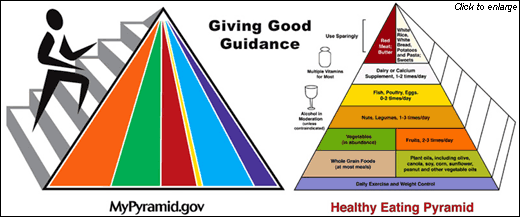Problems Plague New Food Guide Pyramid
by Meir Stampfer, M.D., Dr.P.H., Professor of Epidemiology and Nutrition Chair, Department of Epidemiology, Harvard School of Public Health, Cambridge, Mass.
Assessing the Original
The basic premise underlying the original pyramid was to limit intake of cholesterol and to reduce consumption of saturated fat. While differences in the health effects of diverse forms of dietary fat were well understood, it was thought that the nuances of type of fat would be too complex for Americans, hence the simple message, “Fat is bad.” Because protein does not normally vary a lot in the diet, and is often associated with fat, the directive was to replace calories from fat with carbohydrates, which resided at the base of the pyramid. Americans were told to eat six to 11 servings per day of carbohydrates in the form of grain products.
Although millions of dollars were spent to develop and promote the original pyramid, virtually no studies assessed whether adherence to that dietary pattern actually improved health. In one such study published in the November 2000 issue of the American Journal of Clinical Nutrition, only a small benefit was observed when compared with a typical American diet. In contrast, adherence to an alternative set of guidelines (see figure) was associated with substantial benefit, as reported in the American Journal of Clinical Nutrition in December 2002.
A Series of Shortcomings
The main problems with the original pyramid were a failure to adequately distinguish types of fat and an overemphasis on carbohydrates with inadequate distinction of the desired types, such as whole grains and sources of dietary fiber. In addition, the pyramid did not distinguish well between healthy and less healthy sources of protein, and it overemphasized milk and red meat.
The Dietary Guidelines for Americans 2005 are a step forward, and the new pyramid does represent an excellent opportunity to right former dietary wrongs. Unfortunately, the new pyramid, or MyPyramid as it is now called, leaves much to be desired.
Based on a customized, Web-based design, the new symbol’s best feature is the addition of a stair-climbing figure representing the need for increased physical activity. But it’s downhill from there. The actual dietary advice is unintelligible from the abstract icon, which is essentially the old pyramid turned on its side with six swaths of color and no clarifying text. Although whole grains now get more attention, carbohydrates remain overemphasized, with little concern shown for the empty calories of added sugar. Because the members of the dietary guidelines panel were required to propose directives that would meet the recommended daily intakes of nutrients from food sources only, including inflated calcium recommendations, dairy products are promoted to an extent unsupportable by contemporary evidence. Meat is also unduly promoted, and differences in the health effects of protein sources are obscured.
Shrouded in Symbol
The 2005 guidelines make genuine progress in distinguishing types of fat — from dreaded trans fat to less-than-desirable saturated fat to consumable unsaturated fats — but the new pyramid tends to conceal this sound advice. In fact, unless people take the time to become familiar with the new icon, they will have no idea what the differently sized color swaths mean (orange for grains, green for vegetables, red for fruits, a teeny band of yellow for oils, blue for milk, and purple for meat and beans); how many daily servings of each food group are recommended (none; it’s all customized via MyPyramid.gov); or any other key nutrition advice the new pyramid proposes to communicate.
Meanwhile, the customized advice for eating from MyPyramid is undercut by a dramatic omission. Individuals with Internet access can obtain tailored advice based on age, gender and physical activity; however, there is no consideration of body size (or of the millions of individuals with no computer access or experience with the World Wide Web).
Although everyone knows that big people eat (and need) more food than small people, the present scheme ignores that. Moreover, no distinction is made between those who need to lose weight and those who do not. The advice is based on calories, but only a compulsive few can track calories with any accuracy. Almost everyone, even those gaining weight, are within a few percentage points of caloric balance; therefore, diet composition, coupled with choosing healthy foods and minimizing unhealthy ones, has the greatest impact on nutrition and health.
Sadly, the new pyramid is a lost opportunity to promote health. But the real losers are the hundreds of millions of Americans who look to it for guidance and advice, and get…a graphic.
[Next Features Article]
